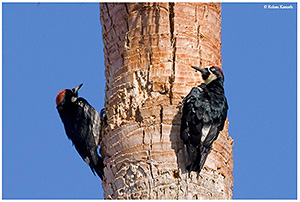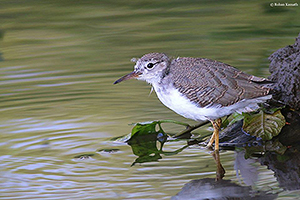Polyandry |
|
|---|---|


photographs of Acorn Woodpeckers (top) and a Spotted Sandpiper by Rohan Kamath |
The
mating of one female with more than one male while each male
mates with only one female is known as polyandry (literally,
"many males"). It is a rare mating system, occurring in less
than one percent of all bird species, and is found mostly in
shorebirds. Polyandry is often accompanied by a reversal of
sexual roles in which males perform all or most parental
duties and females compete for mates. The common pattern of
sexual dimorphism is often reversed in polyandrous birds:
the female is often larger and more colorful than the male.
This reversal confused early biologists and led Audubon to
mislabel males and females in all of his phalarope
plates. Two types of polyandry have been documented: simultaneous polyandry and sequential polyandry. In simultaneous polyandry, each female holds a large territory containing the smaller nesting territories of two or more males who care for the eggs and tend the young. In our region, only Northern jacanas characteristically practice this form of polyandry. Females may mate with all of their consorts in one day and provide each male with help in defending his territory. A female will not copulate with a mate while their eggs are being incubated or during the first six weeks of the fife of the chicks. If a clutch is lost, she will quickly copulate with the broodless male and lay a new batch of eggs within a few days. |
|
A very rare variation on the
preceding theme is "cooperative simultaneous polyandry," in
which more than one male mates with a single female and the
single clutch of mixed parentage is reared cooperatively by
the female and her several mates. This arrangement occurs in
some populations of Harris' Hawks and occasionally in Acorn
Woodpecker groups. In sequential polyandry (the most typical form of this mating system), a female mates with a male, lays eggs, and then terminates the relationship with that male, leaving him to incubate the eggs while she goes off to repeat this sequence with another male. Spotted Sandpipers, Red-necked and Red Phalaropes are examples of sequentially polyandrous species that breed in North America. A possible evolutionary precursor of sequential polyandry is found in Temminck's Stint, Little Stint, Mountain Plover, and Sanderling. In these species, each female lays a clutch of eggs that is incubated by the male, followed by a second clutch that she incubates herself. These two-clutch systems can be envisioned as a step toward the sort of sequential polyandry seen in the Spotted Sandpiper, but females of that species never incubate a clutch alone unless their mate is killed -- even when resources are abundant. There is an interesting sidelight to the story of polyandry in birds. In polygynous mammals (one male mating with several females) such as lions and gorillas, infanticide can occur when a new male takes over a harem. By killing the young of the previous harem ruler, the new male presumably brings females back into heat. This gives him a chance to increase his own reproductive contributions and, perhaps, to reduce use of resources by unrelated offspring. In Northern jacanas it has been reported that females taking over the territories of other females occasionally practice infanticide, destroying the offspring of previous females. The males attempt to defend their broods (which represent their genes, but not those of the new female), just as lionesses attempt to defend their cubs from infanticidal male lions taking over a pride. However, the actual killing of young has not been observed -- only empty nests. If substantiated, this behavior in jacanas is the first known example of infanticide being used as a reproductive strategy by females. |
|
| SEE:
Polyandry in the Spotted Sandpiper;
Monogamy;
Polygyny;
Cooperative Breeding;
Natural Selection. Copyright ® 1988 by Paul R. Ehrlich, David S. Dobkin, and Darryl Wheye. |
|